The Best Way to Reduce Street Crime: Criminologists' Views
VerifiedAdded on 2023/03/17
|9
|1859
|82
Essay
AI Summary
This research paper investigates the optimal methods for reducing street crime, contrasting the effectiveness of increasing police presence with alternative strategies. It begins by outlining the role of the criminal justice system and policing in crime prevention within the Australian context, including the police-citizen ratio and associated costs. The paper then delves into the perspectives of criminologists and scholars, examining their views on the limitations of solely relying on increased police numbers and highlighting alternative, cost-effective approaches. These alternatives include job creation for youths, income increases, a well-functioning rehabilitative criminal justice system, prevention of drug and substance abuse, enhanced social security benefits, improved standards of living, and economic stability. Findings emphasize the high costs of policing and the need for a multifaceted approach to crime alleviation, while conclusions reiterate the importance of proactive measures and the coordination of government departments. The paper ultimately argues for a balanced strategy that incorporates both deterrent and preventative measures, drawing on scholarly research to support its recommendations.
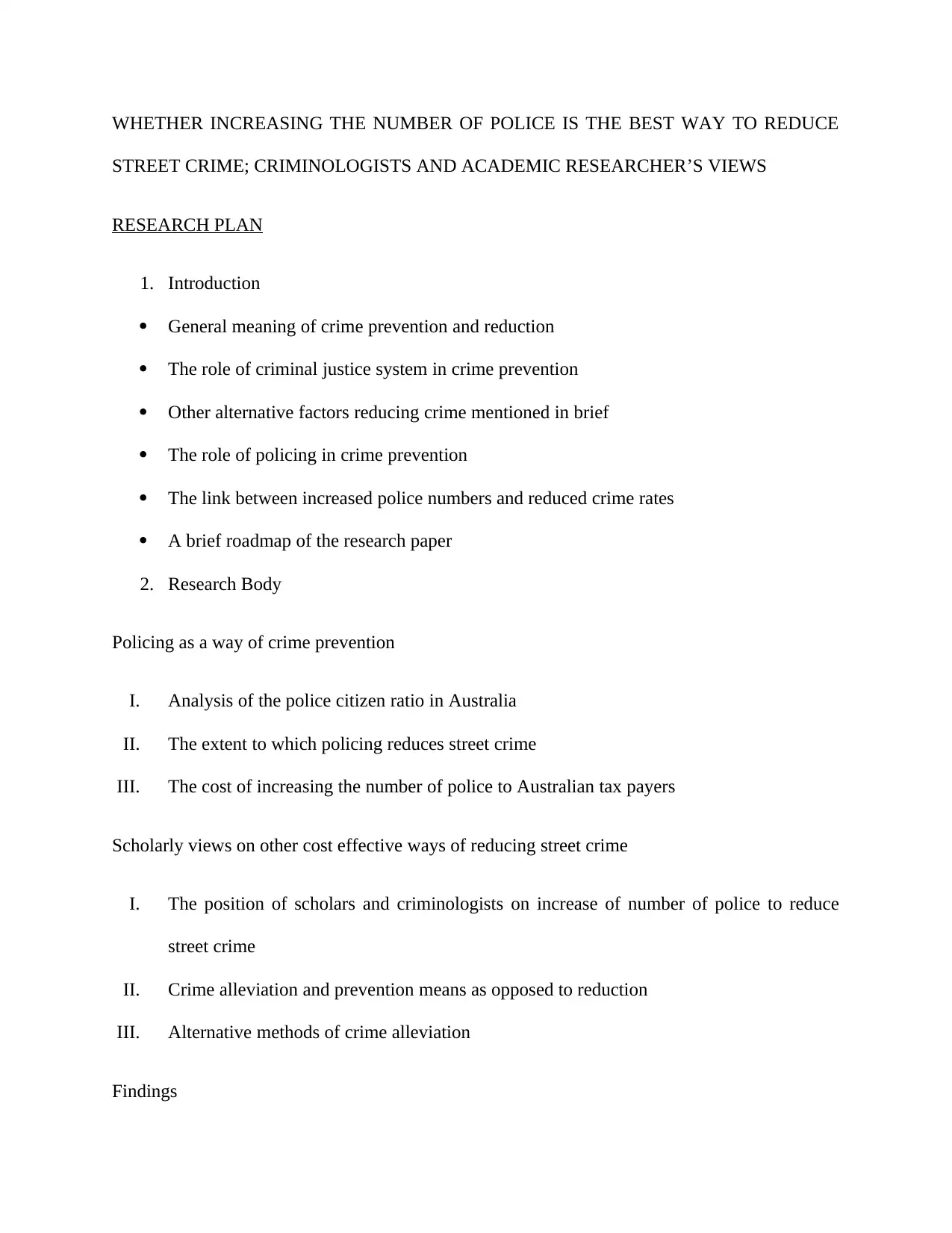
WHETHER INCREASING THE NUMBER OF POLICE IS THE BEST WAY TO REDUCE
STREET CRIME; CRIMINOLOGISTS AND ACADEMIC RESEARCHER’S VIEWS
RESEARCH PLAN
1. Introduction
General meaning of crime prevention and reduction
The role of criminal justice system in crime prevention
Other alternative factors reducing crime mentioned in brief
The role of policing in crime prevention
The link between increased police numbers and reduced crime rates
A brief roadmap of the research paper
2. Research Body
Policing as a way of crime prevention
I. Analysis of the police citizen ratio in Australia
II. The extent to which policing reduces street crime
III. The cost of increasing the number of police to Australian tax payers
Scholarly views on other cost effective ways of reducing street crime
I. The position of scholars and criminologists on increase of number of police to reduce
street crime
II. Crime alleviation and prevention means as opposed to reduction
III. Alternative methods of crime alleviation
Findings
STREET CRIME; CRIMINOLOGISTS AND ACADEMIC RESEARCHER’S VIEWS
RESEARCH PLAN
1. Introduction
General meaning of crime prevention and reduction
The role of criminal justice system in crime prevention
Other alternative factors reducing crime mentioned in brief
The role of policing in crime prevention
The link between increased police numbers and reduced crime rates
A brief roadmap of the research paper
2. Research Body
Policing as a way of crime prevention
I. Analysis of the police citizen ratio in Australia
II. The extent to which policing reduces street crime
III. The cost of increasing the number of police to Australian tax payers
Scholarly views on other cost effective ways of reducing street crime
I. The position of scholars and criminologists on increase of number of police to reduce
street crime
II. Crime alleviation and prevention means as opposed to reduction
III. Alternative methods of crime alleviation
Findings
Paraphrase This Document
Need a fresh take? Get an instant paraphrase of this document with our AI Paraphraser

Consists of important views and why they are important
Conclusion
Summary of arguments
Rational for the arguments
Final take to convince the reader
Conclusion
Summary of arguments
Rational for the arguments
Final take to convince the reader
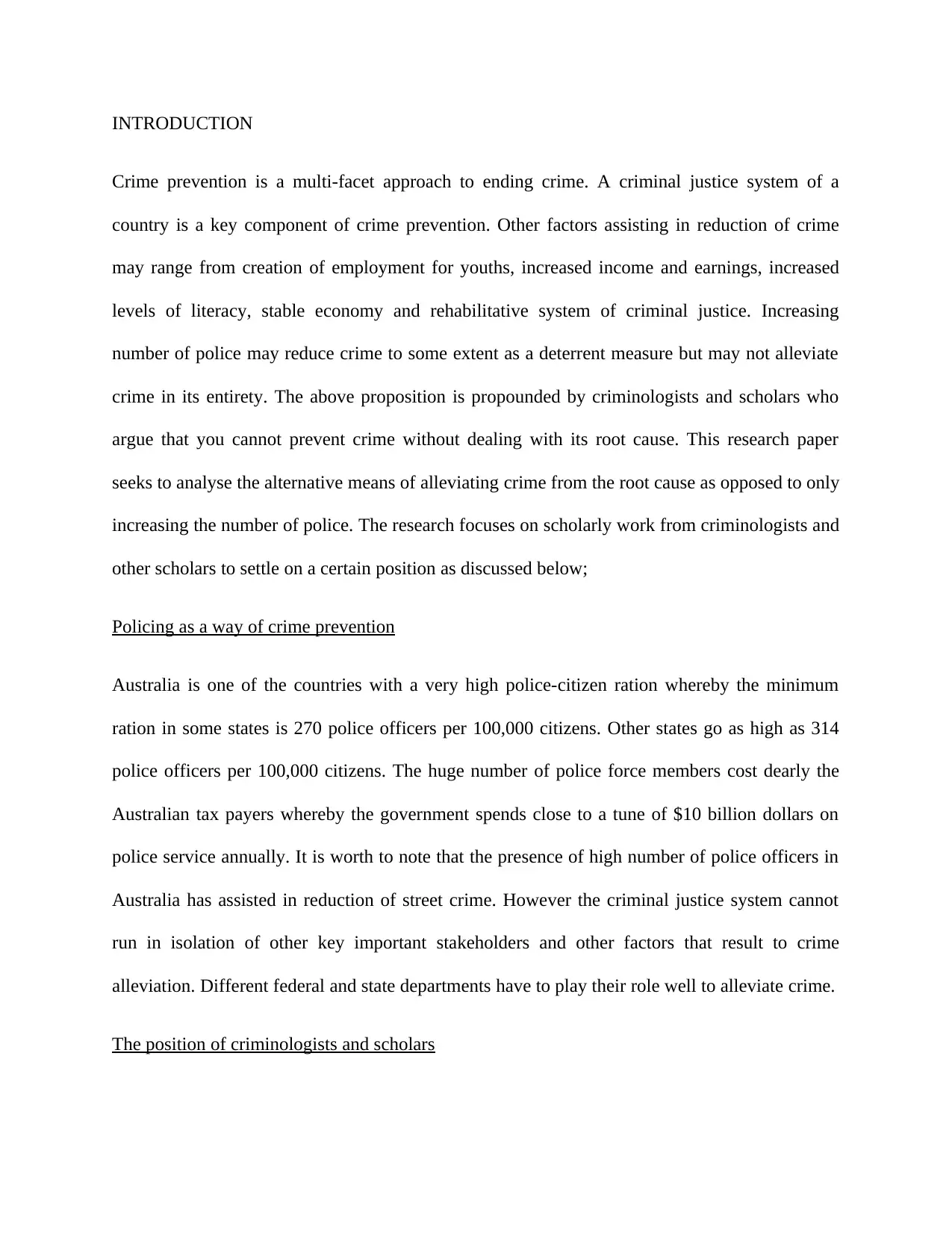
INTRODUCTION
Crime prevention is a multi-facet approach to ending crime. A criminal justice system of a
country is a key component of crime prevention. Other factors assisting in reduction of crime
may range from creation of employment for youths, increased income and earnings, increased
levels of literacy, stable economy and rehabilitative system of criminal justice. Increasing
number of police may reduce crime to some extent as a deterrent measure but may not alleviate
crime in its entirety. The above proposition is propounded by criminologists and scholars who
argue that you cannot prevent crime without dealing with its root cause. This research paper
seeks to analyse the alternative means of alleviating crime from the root cause as opposed to only
increasing the number of police. The research focuses on scholarly work from criminologists and
other scholars to settle on a certain position as discussed below;
Policing as a way of crime prevention
Australia is one of the countries with a very high police-citizen ration whereby the minimum
ration in some states is 270 police officers per 100,000 citizens. Other states go as high as 314
police officers per 100,000 citizens. The huge number of police force members cost dearly the
Australian tax payers whereby the government spends close to a tune of $10 billion dollars on
police service annually. It is worth to note that the presence of high number of police officers in
Australia has assisted in reduction of street crime. However the criminal justice system cannot
run in isolation of other key important stakeholders and other factors that result to crime
alleviation. Different federal and state departments have to play their role well to alleviate crime.
The position of criminologists and scholars
Crime prevention is a multi-facet approach to ending crime. A criminal justice system of a
country is a key component of crime prevention. Other factors assisting in reduction of crime
may range from creation of employment for youths, increased income and earnings, increased
levels of literacy, stable economy and rehabilitative system of criminal justice. Increasing
number of police may reduce crime to some extent as a deterrent measure but may not alleviate
crime in its entirety. The above proposition is propounded by criminologists and scholars who
argue that you cannot prevent crime without dealing with its root cause. This research paper
seeks to analyse the alternative means of alleviating crime from the root cause as opposed to only
increasing the number of police. The research focuses on scholarly work from criminologists and
other scholars to settle on a certain position as discussed below;
Policing as a way of crime prevention
Australia is one of the countries with a very high police-citizen ration whereby the minimum
ration in some states is 270 police officers per 100,000 citizens. Other states go as high as 314
police officers per 100,000 citizens. The huge number of police force members cost dearly the
Australian tax payers whereby the government spends close to a tune of $10 billion dollars on
police service annually. It is worth to note that the presence of high number of police officers in
Australia has assisted in reduction of street crime. However the criminal justice system cannot
run in isolation of other key important stakeholders and other factors that result to crime
alleviation. Different federal and state departments have to play their role well to alleviate crime.
The position of criminologists and scholars
⊘ This is a preview!⊘
Do you want full access?
Subscribe today to unlock all pages.

Trusted by 1+ million students worldwide
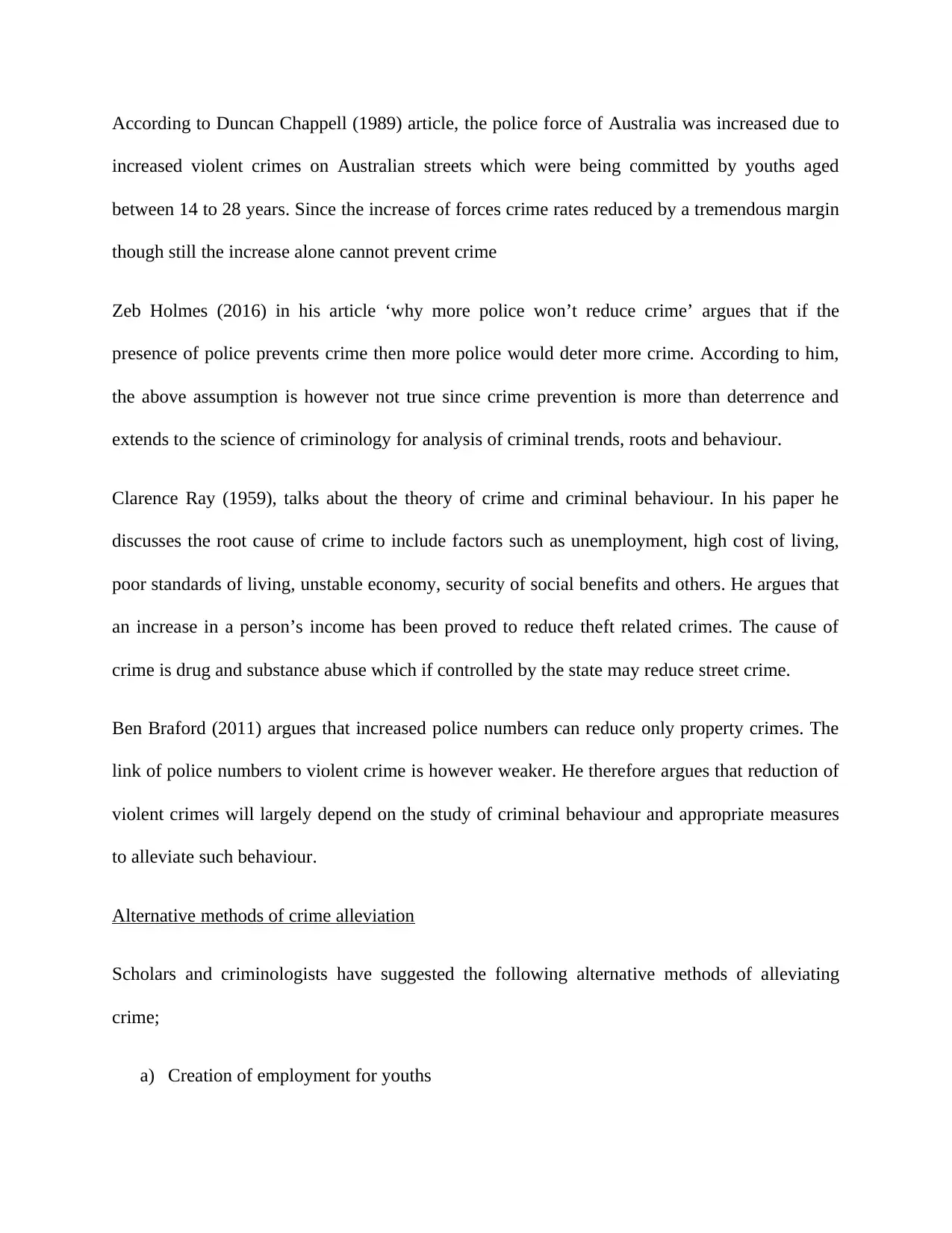
According to Duncan Chappell (1989) article, the police force of Australia was increased due to
increased violent crimes on Australian streets which were being committed by youths aged
between 14 to 28 years. Since the increase of forces crime rates reduced by a tremendous margin
though still the increase alone cannot prevent crime
Zeb Holmes (2016) in his article ‘why more police won’t reduce crime’ argues that if the
presence of police prevents crime then more police would deter more crime. According to him,
the above assumption is however not true since crime prevention is more than deterrence and
extends to the science of criminology for analysis of criminal trends, roots and behaviour.
Clarence Ray (1959), talks about the theory of crime and criminal behaviour. In his paper he
discusses the root cause of crime to include factors such as unemployment, high cost of living,
poor standards of living, unstable economy, security of social benefits and others. He argues that
an increase in a person’s income has been proved to reduce theft related crimes. The cause of
crime is drug and substance abuse which if controlled by the state may reduce street crime.
Ben Braford (2011) argues that increased police numbers can reduce only property crimes. The
link of police numbers to violent crime is however weaker. He therefore argues that reduction of
violent crimes will largely depend on the study of criminal behaviour and appropriate measures
to alleviate such behaviour.
Alternative methods of crime alleviation
Scholars and criminologists have suggested the following alternative methods of alleviating
crime;
a) Creation of employment for youths
increased violent crimes on Australian streets which were being committed by youths aged
between 14 to 28 years. Since the increase of forces crime rates reduced by a tremendous margin
though still the increase alone cannot prevent crime
Zeb Holmes (2016) in his article ‘why more police won’t reduce crime’ argues that if the
presence of police prevents crime then more police would deter more crime. According to him,
the above assumption is however not true since crime prevention is more than deterrence and
extends to the science of criminology for analysis of criminal trends, roots and behaviour.
Clarence Ray (1959), talks about the theory of crime and criminal behaviour. In his paper he
discusses the root cause of crime to include factors such as unemployment, high cost of living,
poor standards of living, unstable economy, security of social benefits and others. He argues that
an increase in a person’s income has been proved to reduce theft related crimes. The cause of
crime is drug and substance abuse which if controlled by the state may reduce street crime.
Ben Braford (2011) argues that increased police numbers can reduce only property crimes. The
link of police numbers to violent crime is however weaker. He therefore argues that reduction of
violent crimes will largely depend on the study of criminal behaviour and appropriate measures
to alleviate such behaviour.
Alternative methods of crime alleviation
Scholars and criminologists have suggested the following alternative methods of alleviating
crime;
a) Creation of employment for youths
Paraphrase This Document
Need a fresh take? Get an instant paraphrase of this document with our AI Paraphraser
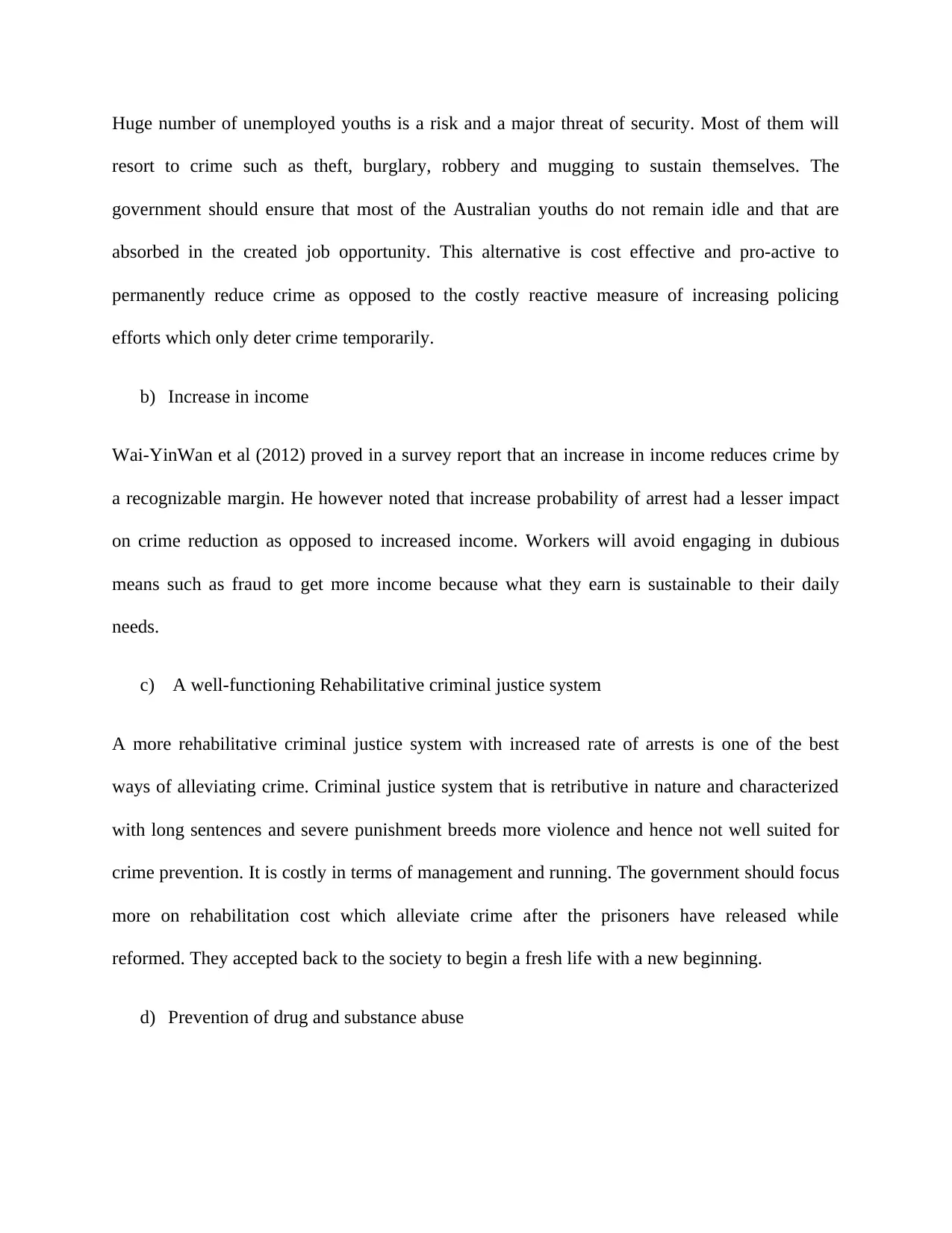
Huge number of unemployed youths is a risk and a major threat of security. Most of them will
resort to crime such as theft, burglary, robbery and mugging to sustain themselves. The
government should ensure that most of the Australian youths do not remain idle and that are
absorbed in the created job opportunity. This alternative is cost effective and pro-active to
permanently reduce crime as opposed to the costly reactive measure of increasing policing
efforts which only deter crime temporarily.
b) Increase in income
Wai-YinWan et al (2012) proved in a survey report that an increase in income reduces crime by
a recognizable margin. He however noted that increase probability of arrest had a lesser impact
on crime reduction as opposed to increased income. Workers will avoid engaging in dubious
means such as fraud to get more income because what they earn is sustainable to their daily
needs.
c) A well-functioning Rehabilitative criminal justice system
A more rehabilitative criminal justice system with increased rate of arrests is one of the best
ways of alleviating crime. Criminal justice system that is retributive in nature and characterized
with long sentences and severe punishment breeds more violence and hence not well suited for
crime prevention. It is costly in terms of management and running. The government should focus
more on rehabilitation cost which alleviate crime after the prisoners have released while
reformed. They accepted back to the society to begin a fresh life with a new beginning.
d) Prevention of drug and substance abuse
resort to crime such as theft, burglary, robbery and mugging to sustain themselves. The
government should ensure that most of the Australian youths do not remain idle and that are
absorbed in the created job opportunity. This alternative is cost effective and pro-active to
permanently reduce crime as opposed to the costly reactive measure of increasing policing
efforts which only deter crime temporarily.
b) Increase in income
Wai-YinWan et al (2012) proved in a survey report that an increase in income reduces crime by
a recognizable margin. He however noted that increase probability of arrest had a lesser impact
on crime reduction as opposed to increased income. Workers will avoid engaging in dubious
means such as fraud to get more income because what they earn is sustainable to their daily
needs.
c) A well-functioning Rehabilitative criminal justice system
A more rehabilitative criminal justice system with increased rate of arrests is one of the best
ways of alleviating crime. Criminal justice system that is retributive in nature and characterized
with long sentences and severe punishment breeds more violence and hence not well suited for
crime prevention. It is costly in terms of management and running. The government should focus
more on rehabilitation cost which alleviate crime after the prisoners have released while
reformed. They accepted back to the society to begin a fresh life with a new beginning.
d) Prevention of drug and substance abuse

Majority of violent crime such rape and even murder happens because some of the suspects are
usually under the influence of drugs which might cause depression. Stress and depression if not
controlled has dire consequences. The government has to invest in fighting drug trafficking and
rehabilitation of drug addiction victims to alleviate crime.
e) Increased social security benefits
When the government assures its citizens of social security, they remain calm knowing that their
feature economic life is sorted. Assurance of economic security reduces property related crime to
a greater extent.
f) High standard of living and low cost of living
When the standard of living is low, the cost of living is always hence more people lack
purchasing power of consumables and other basic items. The situation may culminate to
increased social unrest, theft and burglary due to poverty. The country should always ensure that
citizens enjoy value for their money paid to government inform of taxes by offering them
affordable high quality goods and services.
g) Stable economy
The government should work towards stabilized economy to avoid inflation which might result
to increased crime rates. Inflation will result to high cost of living. The situation will in turn
make people fail to afford their daily needs due to increased prices of goods and services.
FINDINGS, CONCLUSIONS AND RECOMMENDATIONS
Findings
usually under the influence of drugs which might cause depression. Stress and depression if not
controlled has dire consequences. The government has to invest in fighting drug trafficking and
rehabilitation of drug addiction victims to alleviate crime.
e) Increased social security benefits
When the government assures its citizens of social security, they remain calm knowing that their
feature economic life is sorted. Assurance of economic security reduces property related crime to
a greater extent.
f) High standard of living and low cost of living
When the standard of living is low, the cost of living is always hence more people lack
purchasing power of consumables and other basic items. The situation may culminate to
increased social unrest, theft and burglary due to poverty. The country should always ensure that
citizens enjoy value for their money paid to government inform of taxes by offering them
affordable high quality goods and services.
g) Stable economy
The government should work towards stabilized economy to avoid inflation which might result
to increased crime rates. Inflation will result to high cost of living. The situation will in turn
make people fail to afford their daily needs due to increased prices of goods and services.
FINDINGS, CONCLUSIONS AND RECOMMENDATIONS
Findings
⊘ This is a preview!⊘
Do you want full access?
Subscribe today to unlock all pages.

Trusted by 1+ million students worldwide
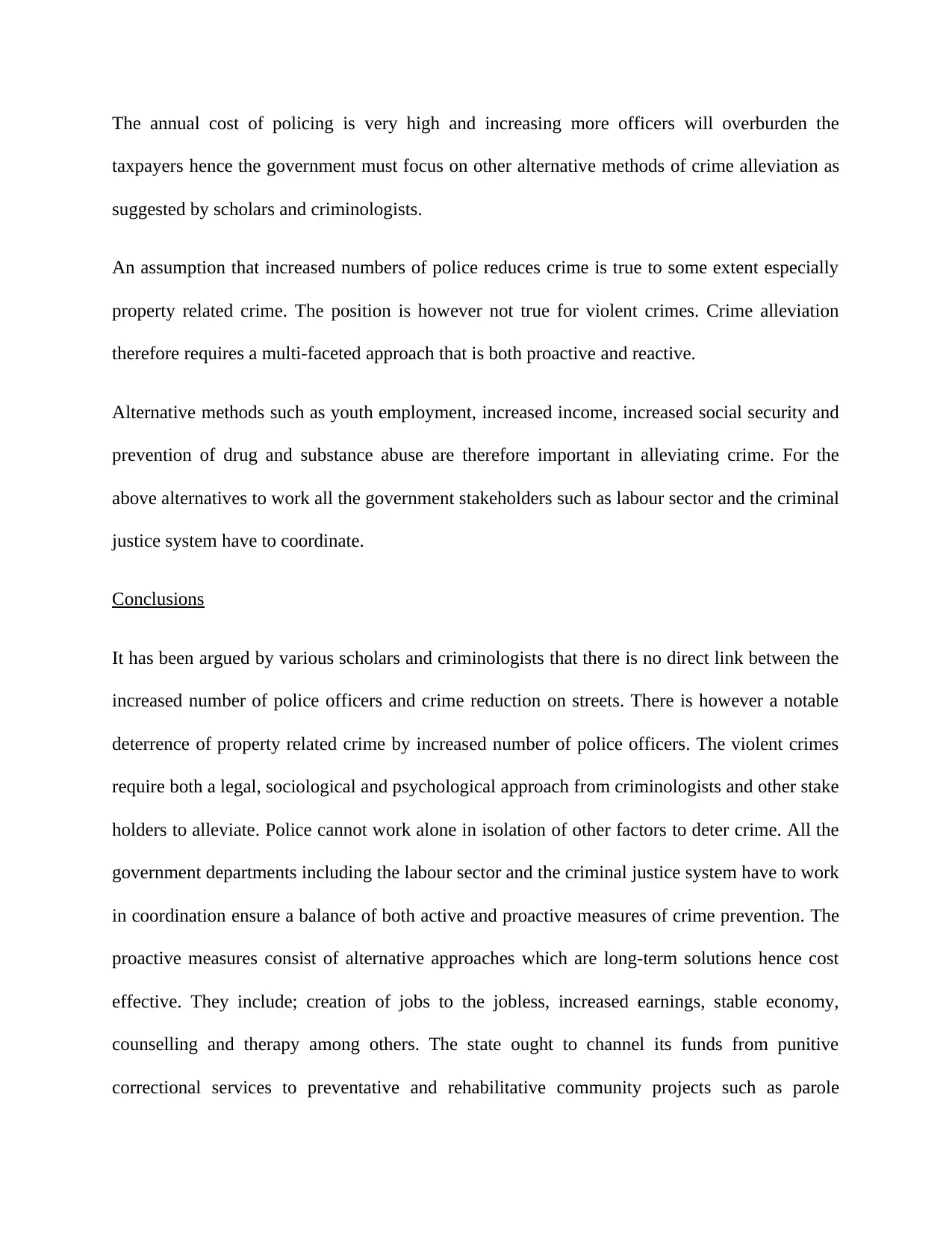
The annual cost of policing is very high and increasing more officers will overburden the
taxpayers hence the government must focus on other alternative methods of crime alleviation as
suggested by scholars and criminologists.
An assumption that increased numbers of police reduces crime is true to some extent especially
property related crime. The position is however not true for violent crimes. Crime alleviation
therefore requires a multi-faceted approach that is both proactive and reactive.
Alternative methods such as youth employment, increased income, increased social security and
prevention of drug and substance abuse are therefore important in alleviating crime. For the
above alternatives to work all the government stakeholders such as labour sector and the criminal
justice system have to coordinate.
Conclusions
It has been argued by various scholars and criminologists that there is no direct link between the
increased number of police officers and crime reduction on streets. There is however a notable
deterrence of property related crime by increased number of police officers. The violent crimes
require both a legal, sociological and psychological approach from criminologists and other stake
holders to alleviate. Police cannot work alone in isolation of other factors to deter crime. All the
government departments including the labour sector and the criminal justice system have to work
in coordination ensure a balance of both active and proactive measures of crime prevention. The
proactive measures consist of alternative approaches which are long-term solutions hence cost
effective. They include; creation of jobs to the jobless, increased earnings, stable economy,
counselling and therapy among others. The state ought to channel its funds from punitive
correctional services to preventative and rehabilitative community projects such as parole
taxpayers hence the government must focus on other alternative methods of crime alleviation as
suggested by scholars and criminologists.
An assumption that increased numbers of police reduces crime is true to some extent especially
property related crime. The position is however not true for violent crimes. Crime alleviation
therefore requires a multi-faceted approach that is both proactive and reactive.
Alternative methods such as youth employment, increased income, increased social security and
prevention of drug and substance abuse are therefore important in alleviating crime. For the
above alternatives to work all the government stakeholders such as labour sector and the criminal
justice system have to coordinate.
Conclusions
It has been argued by various scholars and criminologists that there is no direct link between the
increased number of police officers and crime reduction on streets. There is however a notable
deterrence of property related crime by increased number of police officers. The violent crimes
require both a legal, sociological and psychological approach from criminologists and other stake
holders to alleviate. Police cannot work alone in isolation of other factors to deter crime. All the
government departments including the labour sector and the criminal justice system have to work
in coordination ensure a balance of both active and proactive measures of crime prevention. The
proactive measures consist of alternative approaches which are long-term solutions hence cost
effective. They include; creation of jobs to the jobless, increased earnings, stable economy,
counselling and therapy among others. The state ought to channel its funds from punitive
correctional services to preventative and rehabilitative community projects such as parole
Paraphrase This Document
Need a fresh take? Get an instant paraphrase of this document with our AI Paraphraser

probation programs and others. Increase in social security and economic security has been
proved to reduce crime to a higher rate as opposed to increased probability of police arrests.
proved to reduce crime to a higher rate as opposed to increased probability of police arrests.
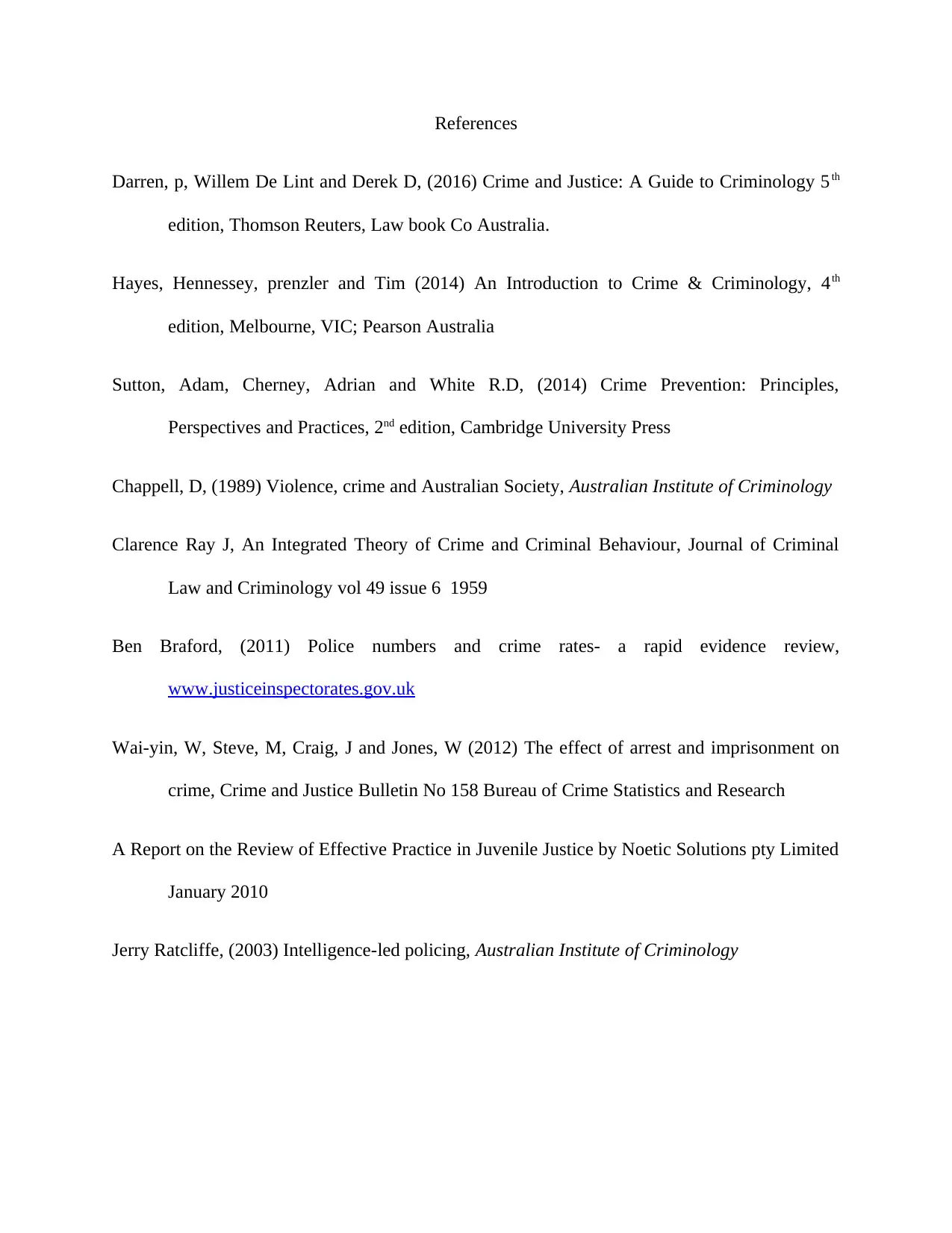
References
Darren, p, Willem De Lint and Derek D, (2016) Crime and Justice: A Guide to Criminology 5th
edition, Thomson Reuters, Law book Co Australia.
Hayes, Hennessey, prenzler and Tim (2014) An Introduction to Crime & Criminology, 4th
edition, Melbourne, VIC; Pearson Australia
Sutton, Adam, Cherney, Adrian and White R.D, (2014) Crime Prevention: Principles,
Perspectives and Practices, 2nd edition, Cambridge University Press
Chappell, D, (1989) Violence, crime and Australian Society, Australian Institute of Criminology
Clarence Ray J, An Integrated Theory of Crime and Criminal Behaviour, Journal of Criminal
Law and Criminology vol 49 issue 6 1959
Ben Braford, (2011) Police numbers and crime rates- a rapid evidence review,
www.justiceinspectorates.gov.uk
Wai-yin, W, Steve, M, Craig, J and Jones, W (2012) The effect of arrest and imprisonment on
crime, Crime and Justice Bulletin No 158 Bureau of Crime Statistics and Research
A Report on the Review of Effective Practice in Juvenile Justice by Noetic Solutions pty Limited
January 2010
Jerry Ratcliffe, (2003) Intelligence-led policing, Australian Institute of Criminology
Darren, p, Willem De Lint and Derek D, (2016) Crime and Justice: A Guide to Criminology 5th
edition, Thomson Reuters, Law book Co Australia.
Hayes, Hennessey, prenzler and Tim (2014) An Introduction to Crime & Criminology, 4th
edition, Melbourne, VIC; Pearson Australia
Sutton, Adam, Cherney, Adrian and White R.D, (2014) Crime Prevention: Principles,
Perspectives and Practices, 2nd edition, Cambridge University Press
Chappell, D, (1989) Violence, crime and Australian Society, Australian Institute of Criminology
Clarence Ray J, An Integrated Theory of Crime and Criminal Behaviour, Journal of Criminal
Law and Criminology vol 49 issue 6 1959
Ben Braford, (2011) Police numbers and crime rates- a rapid evidence review,
www.justiceinspectorates.gov.uk
Wai-yin, W, Steve, M, Craig, J and Jones, W (2012) The effect of arrest and imprisonment on
crime, Crime and Justice Bulletin No 158 Bureau of Crime Statistics and Research
A Report on the Review of Effective Practice in Juvenile Justice by Noetic Solutions pty Limited
January 2010
Jerry Ratcliffe, (2003) Intelligence-led policing, Australian Institute of Criminology
⊘ This is a preview!⊘
Do you want full access?
Subscribe today to unlock all pages.

Trusted by 1+ million students worldwide
1 out of 9
Related Documents
Your All-in-One AI-Powered Toolkit for Academic Success.
+13062052269
info@desklib.com
Available 24*7 on WhatsApp / Email
![[object Object]](/_next/static/media/star-bottom.7253800d.svg)
Unlock your academic potential
Copyright © 2020–2025 A2Z Services. All Rights Reserved. Developed and managed by ZUCOL.




